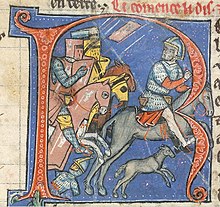Battle of Harim
This article includes a list of general references, but it lacks sufficient corresponding inline citations. (April 2008) |
| Battle of Harim | |||||||
|---|---|---|---|---|---|---|---|
| Part of the Crusades | |||||||
 Mail-coated Nur al-Din Zengi, with bare legs and an open helmet, fleeing on horseback from two knights (Geoffrey Martel and Hugh de Lusignan the elder) pursuing him on war horses at the Battle of Harim. "Histoire d'Outremer" (1232-1261) - BL Yates Thompson MS 12 | |||||||
| |||||||
| Belligerents | |||||||
|
Zengids Mosul |
County of Tripoli Principality of Antioch Byzantine Empire Armenia | ||||||
| Commanders and leaders | |||||||
|
Qutb ad-Din Mawdud |
Joscelin III of Edessa (POW ) | ||||||
| Strength | |||||||
| 9,000 |
600 knights 12,000 foot soldiers[1] | ||||||
| Casualties and losses | |||||||
| Unknown |
10,000 (per Ibn al-Athir)[2] Kalamanos, Hugh, Raymond, Bohemund, Joscelin captured | ||||||
The Battle of Harim (Harenc) was fought on 12 August 1164 at
Background
In 1163, King
Battle
Reginald of Saint Valery, lord of Harim,[
Nur ad-Din prepared to give up the siege when they arrived, but the crusaders, inspired by the victory at al-Buqaia, and, "regardless of the rules of military discipline ... recklessly dispersed and roved hither and yon in pursuit of the foe." Nur ad-Din's troops defended against their charge and led a counterattack, pushing the crusaders into a swamp, and they were massacred "like victims before the altar."
It is possible that Nur ad-Din was only feigning a retreat in order to draw the crusaders into an ambush, but abandoning a siege when a relief army arrived was a standard tactic and Nur ad-Din presumably had no way of knowing the crusaders would follow him. William's assertion that this was a reckless move is further evidence of this. "Only the Armenian Thoros, who had forseen [sic?] the Turkish maneuver and had not set off in pursuit, escaped from the disaster".[4] Mleh also avoided capture. Konstantinos Kalamanos, Hugh, Raymond, Bohemund, and Joscelin were captured and imprisoned in Aleppo. According to Ibn al-Athir, 10,000 crusaders were killed.
Aftermath
Nur ad-Din resumed the siege and captured Harim a few days later. With Amalric absent in Egypt, all three crusader states were now without their rulers, but Nur ad-Din did not want to attack
Notes
- ^ Barber 2012, p. 240: "(Nur ad-Din) completely routed a formidable northern army, killing a large proportion of its 600 knights and 12,000 foot soldiers, and capturing all the important leaders, including Raymond III, count of Tripoli, Bohemond III, prince of Antioch, Joscelin III, titular count of Edessa, and Constantine Coloman, Byzantine governor of Cilicia.".
- ^ Morton, Nicholas. The Crusader States and Their Neighbours: A Military History, 1099–1187. United Kingdom: Oxford University Press, 2020.
- ^ Oldenbourg 1966, p. 363.
- ^ a b Oldenbourg 1966, p. 364.
References
- Oldenbourg, Zoé (1966). The Crusades. New York: Pantheon Books.
- Barber, Malcolm (2012). The Crusader States. New Haven and London: Yale University.
- Runciman, Steven (1952). A History of the Crusades: Volume II, the Kingdom of Jerusalem and the Frankish East, 1100–1187. New York: Cambridge University.
Further reading
- Maalouf, Amin, The Crusades Through Arab Eyes, trans. Jon Rothschild. Al-Saqi, 1984.
- Runciman, Steven, A History of the Crusades, vol. II: The Kingdom of Jerusalem. Cambridge University Press, 1952.
- Smail, R. C. Crusading Warfare, 1097–1193. Cambridge University Press, 1956 (2nd ed., 1995). ISBN 1-56619-769-4
- William of Tyre, A History of Deeds Done Beyond the Sea, trans. E.A. Babcock and A.C. Krey. Columbia University Press, 1943.
